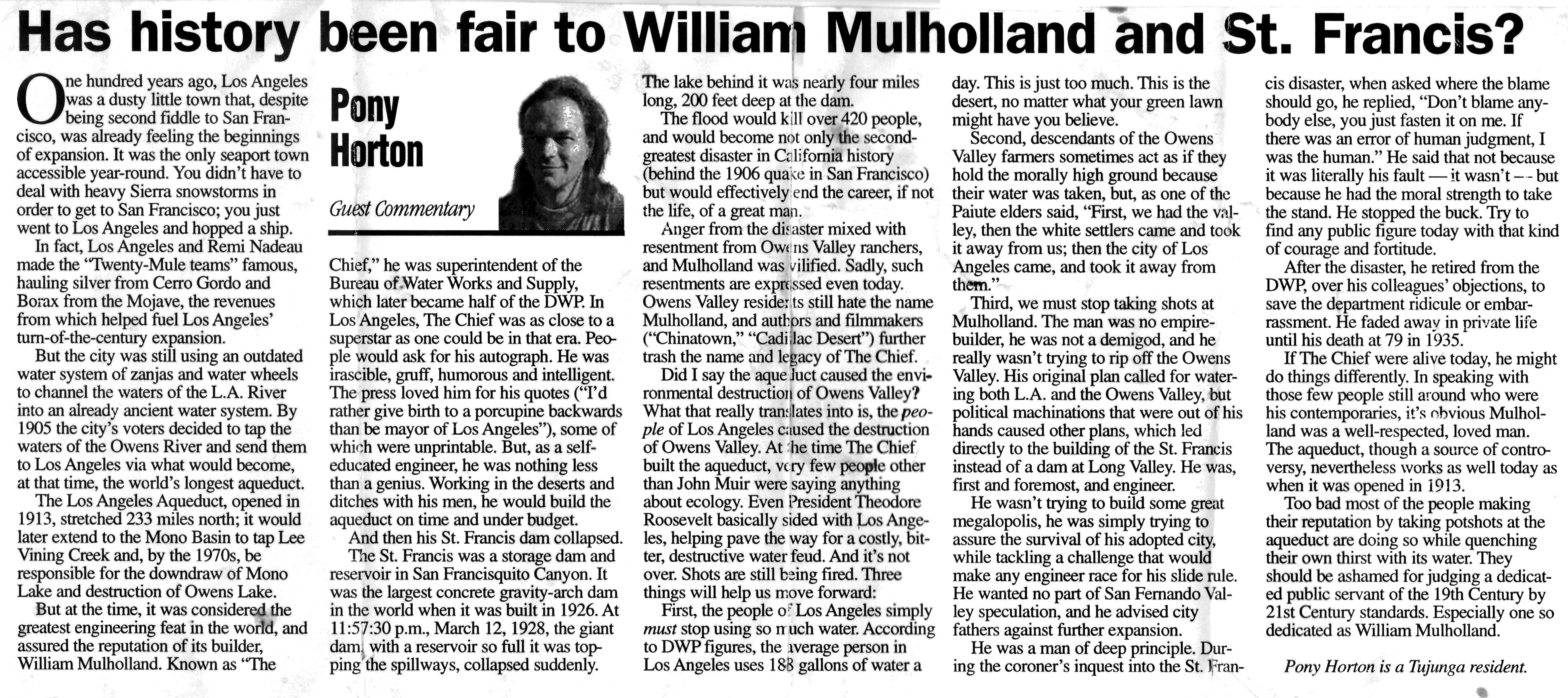Historical Op Ed Pieces |
Los Angeles City Watch
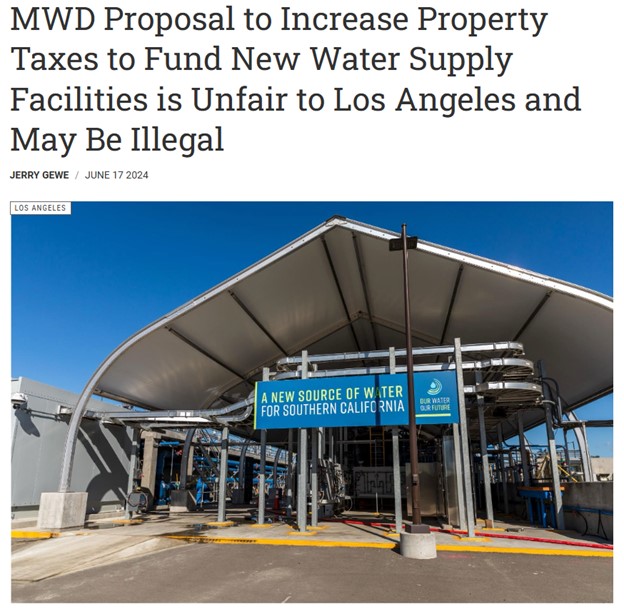
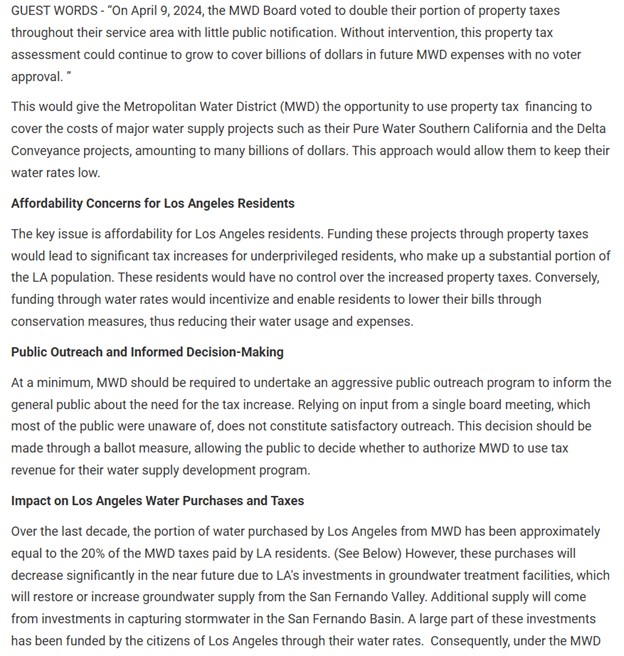
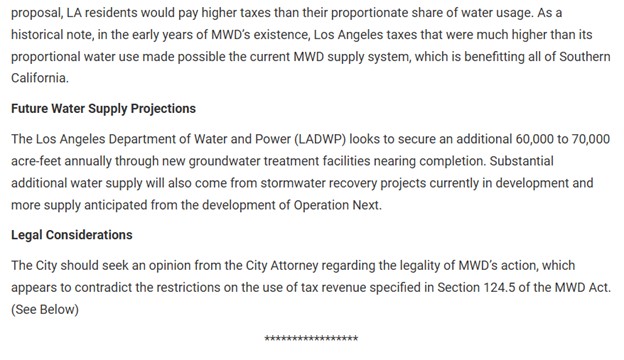

Click HERE for direct link to article.
* * * * * |
HISTORY vs CONSPIRACY |
or |
POPULAR vs SCHOLARLY RESEARCH |
||
| By Abraham Hoffman, historian and author. |
June 20, 2020 |
"The coronavirus pandemic is a hoax created by Democrats to embarrass the Trump Administration.” “The Chinese created the virus in a secret lab with the intention of using it as bacteriological warfare against the United States, but inadvertently let it out across Asia, the Americas, Africa, and Europe.” Add to these spurious claims the hundreds of conspiracy theories (if not thousands and thousands) on the Internet, and eventually gullible people will believe that some unknown power—the Mafia in league with the Freemasons, Zionists, the CIA, the Tri-Lateral Commission, the Illuminati, OPEC, and the Los Angeles Department of Water and Power (if it’s an unknown power, the named entities present a contradiction to the theory) is out to control the world. Do not worry: Jason Bourne or James Bond will save us at the last moment (never mind that they are fictional characters). On a more serious note, some conspiracies continue to exist long after research has exposed them to be untrue, wildly exaggerated, or on the surface, seem plausible enough even though they have been debunked through scholarship. Case in point: The Owens Valley-Los Angeles water controversy. The latest example of an obsolete conspiracy getting new attention appears in the June 2020 issue of American History, a magazine published in print and online by The History Net, a company that publishes several “popular” history magazines. These magazines differ from academic journals in that they have no footnotes or bibliography. An exception to the rule would be American Heritage where fact checkers make certain the articles are factually correct. Take, for example, the article “When LA Unions Fought for the Right to Strike, One Weapon was Dynamite,” by Kenny Kemp, an author whose web site bills him as a “Storyteller.” The subtitle of the article says, “The bombing of the Los Angeles Times exposed a business plot to steal water supply and make the rich richer.” Kemp relates how Harrison Gray Otis led a campaign against labor unions that culminated in the bombing of the Los Angeles Times building on October 1, 1910, killing twenty people and injuring many others. Kemp essentially retells a story that is well known in Los Angeles history but, as noted, he’s a storyteller. Herbert Shapiro wrote “The McNamara Case: A Crisis of the Progressive Era,” in the Fall 1977 issue of Southern California Quarterly. Shapiro, unlike Kemp, is a historian, and he documents his article with end notes demonstrating his research. Amore recent example comes from Aaron Tate, author of “The Los Angeles Times Bombing and the McNamaras Trial,” in the June 2020 issue of Branding Iron, published by the Los Angeles Corral of Westerners. Tate’s article is documented with end notes and a bibliography of sources consulted. Although Kemp devotes most of his article to the Times bombing, he also attempts to tie that event to the mayoralty race of 1911 in which Job Harriman, a prominent Socialist attorney, received more votes than did incumbent Mayor George Alexander in the primary election. A run-off was scheduled for December 4—four days after the beginning of the trial of the McNamara brothers. Harriman was also serving on the defense team that was headed by famed attorney Clarence Darrow. Reformer Lincoln Steffens also served on the team. Darrow believed the McNamara brothers were guilty and would receive death sentences. Unknown to Harriman, who was busy with his campaign, Darrow persuaded the brothers to change their pleas to guilty. Instead of a lengthy trial that would provide a forum for labor union arguments, the trial ended on the day it started, December 1. Voters, disillusioned with Harriman’s claims of the brothers’ innocence, chose Alexander to serve another term as mayor. In addition to this fascinating turn of events, Kemp also claimed that “former Mayor Fred Eaton, Los Angeles Water Department [sic] head William Mulholland, and other power brokers were privy to inside information about L.A.’s future. To grow and prosper, the city in the desert needed water.” To characterize Mulholland as a “power broker” is way off the mark. In fact, Mulholland was unhappy with the work of the Suburban Homes Company, a consortium headed by Otis, his son-in-law Harry Chandler, and other leading businessmen. Kemp continues, “Touting a nonexistent federal plan to develop Owens Valley, Eaton and Mulholland conned farmers there into relinquishing their water rights. In 1906, the federal government formally declared it had no plans for the valley. Los Angeles officials quickly announced plans to build a gravity-flow aqueduct to carry valley water to L.A. The December 1911 city election was to include a referendum to authorize issuance of millions of bonds to fund the waterway...Times editorials warned Angelenos that a single drought stood between them and desolation. Knowing that under a scheme still under wraps the city would soon be annexing the San Fernando Valley, Otis and his co-conspirators secretly bought up land there.” Kemp’s tracing of this history contains numerous factual errors and conflates two different episodes into one. The Reclamation Service plan was not “nonexistent.” The agency conducted a preliminary survey of the northern Owens Valley; Mulholland’s plan was to divert water from the Owens River in the southern end. Kemp omits a larger context for the Reclamation Service that ran surveys in a number of western states and territories, but its budget precluded adoption of many of them. The Reclamation Service and city officials agreed in November 1904 to yield to the city’s plans, a decision approved by President Theodore Roosevelt, a personage not mentioned in Kemp’s article. Kemp argues that Eaton and Mulholland “conned farmers there into relinquishing their water rights.” This is simply not true, as is evidenced by Gary Libecap’s important book Owens Valley Revisited, published in 2007, in which Libecap demonstrated that the city paid farmers for the water rights, and no coercion was involved. The “inside information” alleged by Kemp actually took place in 1904, a year after Otis headed a company to develop San Fernando Valley land. By 1911 the effort of a second company, the Suburban Homes Company, was not a secret at all. Kemp confuses two different companies at two different times. The scheme was not “still under wraps” in 1911 as the company was extensively advertising San Fernando Valley land with barbecues and invitations to the public to come and visit the acreage. Bond issues were overwhelmingly approved in 1905 and 1907, not in 1911 as Kemp states. Another point: Los Angeles is located in what is called a “semi-arid” region, not a desert, with an average annual rainfall of around fifteen inches, an amount that sometimes is less, sometimes more, and occasionally a lot more. Historian John W. Robinson effectively demonstrated in his book Gateway to Southern California that Los Angeles, far from being isolated in a desert, was strategically located to serve as an economic hub for the region, with rail and road connections coming through Tejon, Cajon and San Gorgonio Passes. Regarding the claim that a “single drought stood between them and desolation,” the city had endured earlier drought periods, but the Times warning was a specious one. City officials needed the Owens River not because of drought but for the future needs of a rapidly growing city. The bombing of the Times building, a tragic and controversial event, did not “expose a business plot to steal water supply and make the rich richer.” Kemp evidently relied on a minimum of research and some biased sources that unfortunately he did not cite. Biased works such as Los Angeles by Morrow Mayo (1933) and Southern California Country (1946) by Carey McWilliams have long been superseded by serious scholarship. The editors of American History magazine should hire some fact checkers to validate the accuracy of the articles the magazine publishes. There’s nothing wrong with writing for a popular audience, but everything wrong with failing to get the facts straight, and even worse in claiming a nonexistent conspiracy was behind it all.
Article written in response to America History article published in June 2020 Sources to support the arguments in this article: Abraham Hoffman, Vision or Villainy: Origins of the Owens Valley-Los Angeles Water Controversy. Texas A&M University Press, 1981, 1993. Abraham Hoffman, Los Angeles and the Owens Valley: Essays on a Century-Long Water Dispute. Los Angeles Corral of Westerners, 2018. The lead essay in this book, “Water Famine or Water Needs: Los Angeles and Population Growth, 1896-1905,” appeared in the Fall 2000 issue of Southern California Quarterly and was awarded the prestigious What Award for Best Article. Gary Libecap, Owens Valley Revisited: A Reassessment of the West’s First Great Water Transfer. Stanford University Press, 2007. Catherine Mulholland, William Mulholland and the Rise of Los Angeles. University of California Press, 2000. Steve Erie, Beyond Chinatown: The Metropolitan Water District, Growth, and the Environment in Southern California. Stanford University Press, 2006. John W. Robinson, Gateways to Southern California. Big Santa Anita Historical Society, 2005. Aaron Tate, “The Los Angeles Times Bombing and the McNamaras Trial. Branding Iron, No. 298 (June 2020). |
* * * * * |
Ensure Grid Reliability During the Transition to a Clean Energy Future
February 10, 2019 |
The Water and Power Associates supports the City’s goal of a 100% clean energy supply, and we believe the plan put forth by LADWP management is critical to maintaining reliable electric service during the challenging transition period ahead. The Water and Power Associates, a 501(c)4 non-profit corporation, was established in 1971 to inform and educate its members, public officials and the general public on critical water and energy issues affecting the citizens of Los Angeles, Southern California and the State of California. Our members have decades of experience and understand the complexity of the electric grid, physical assets and operational practices which ensure service to residents and businesses day in and day out, regardless of most foreseeable contingencies. Customers expect an endless supply of electric energy at their homes or businesses, whenever they turn on a switch, start an air conditioner, or plug in an electric vehicle. And utilities have an obligation to serve, and must build, operate, maintain or procure all the wires, equipment, and generation needed to serve demand. All of these assets require large capital investments, have long lead times to implement, and often face various degrees of opposition. Few people are aware that when California experiences several days of state-wide prolonged heat, referred to as heat storms by grid operators, that on such days the wind rarely blows, yet power demand reaches peak levels. State mandated “Once-Through Cooling” regulations necessitate the replacement of existing coastal generation units. After numerous studies by experts in the field, staff recommended building new, lower-emitting natural gas fueled generation in the southern areas of the LADWP service area. Some environmental advocates, with a singular focus on implementing renewable power, have opposed this approach. The studies, however, found this to be the only feasible option for maintaining electric reliability. Other options, such as building additional High Voltage transmission which would take decades, are not feasible and do not address the need for local generation for grid stability and voltage support. Battery storage is not feasible due to space requirements for the capacity needed, is not cost effective today, and has its own environmental impacts, such as hazardous waste disposal. Natural gas generation will provide the required flexibility to start or stop in order to coordinate with the variable output of wind and solar resources, and eliminate the possibility of energy brownouts with adverse impacts on the safety and wellbeing of LADWP’s customers. Also keep in mind that natural gas generation may be able to bridge to hydrogen fuel as technology and delivery systems develop over time. The transition to Clean Energy is complex and will take time. Staff has performed the necessary planning studies and processes involving myriad stakeholders. The Associates urge you to consider the information that has been assembled with the careful evaluation of options and support the LADWP staff recommendation. |
* * * * * |
The Delta Water Fix – A Key to Water Reliability and Sustainability
Sep. 10, 2017 |
The City of Los Angeles has grown to a metropolis of over four million people, due in large part to the availability of a safe and reliable supply of water. However, providing this supply took a tremendous amount of foresight, planning, and investment. Over 80 percent of the City’s water supplies originate from sources hundreds of miles away—about 54% from the State Water Project via the Sacramento/San Joaquin Delta, 20% from the Eastern Sierra via the Los Angeles Aqueduct and 10% from the Metropolitan Water District’s Colorado River Aqueduct, The remaining 16 percent of the total supply comes from local groundwater and recycled water. Although the City’s population and economy have steadily grown, the sources of water have remained the same. Consequently, one of the greatest challenges facing the City is providing a reliable water supply while balancing a variety interests, including its commitment to protect and preserve the environment. This balancing act includes planning for the effects of climate change, mitigating against the risk of earthquakes, making proactive investments in local supplies, increasing water-use efficiency, and striving to keep water rates affordable. Even with efforts to increase conservation and develop additional local water supplies, water from the Sacramento-San Joaquin Delta will remain a critical component of the City’s water-reliability equation. Unfortunately, the reliability of imported supplies that support both Los Angeles and all of Southern California are at risk due to pumping restrictions, deteriorating environmental conditions in the Delta, and an aging system. State and federal agencies want to modernize this system through a project known as the California WaterFix which has both water delivery and environmental benefits. The California WaterFix doesn’t just provide environmental benefits for the Delta, it’s also essential for ensuring future water reliability for Los Angeles. When completed, the project will provide the following benefits: • Improves the ability to capture water during major storm events, ultimately storing this water under ground and in reservoirs for Los Angeles in years of drought; • Protects ecosystems and fish in the Delta by constructing intakes with state-of-the-art fish screens; • Protects the billions of dollars invested by Los Angeles to build and maintain the State Water Project, which transports the City’s supplemental water supply from the Delta. As water agencies in southern California prepare to make decisions on whether to support the California WaterFix, they need to set aside politics and support this project as part of a comprehensive approach to ensuring future water reliability. One can only imagine the calamity that would ensue when, not if, storms or a major earthquake cause a significant breach in the Delta levee system. This would be catastrophic, causing seawater intrusion that could contaminate a third of southern California’s freshwater supply and interrupt exports from the southern part of the Delta. Depending on the extent of the damage, it could take 6 to 24 months to repair the system and restore operations. And longer-term disruptions are certainly possible, causing major impacts on the economy and quality of life in Los Angeles. Without the WaterFix or an equivalent solution, this scenario is likely to play out. According to a study by the Los Angeles County Economic Development Corporation**, loses from a 24-month outage of the State Project would result in a loss of 742,000 job-years of employment, $75 billion of gross domestic product (GDP), and $135 billion of sales revenue for businesses in LA County.San Fernando Valley is especially vulnerable to a shortage of State Water supplies. In years when the LA Aqueduct is nearly dry (as happened in 2016), the San Fernando Valley is heavily dependent on imported supplies from the State. Due to the way the MWD and LA systems are plumbed, not enough Colorado River water can make it to the Valley to avoid a shortage. Plans to reduce the City’s dependence on supplies from the Delta and Colorado River, are wise. However, even when the City meets its 2040 local water supply and conservation goals, Angelenos will still be highly dependent on supplies from MWD in dry years, and the majority of this water will still need to come from the Sacramento/San Joaquin Delta. The process to finalize the design, operation, cost allocation, and financing of the California WaterFix is designed to be open and transparent. Estimates indicate that the project can be very cost effective for LA ratepayers, raising water bills by only $2 to $3 per month for the typical residential user^^. These costs pale in comparison to the economic and quality-of-life impacts of a catastrophe in the Delta, and the ensuing loss of water deliveries from the State Water Project. Amidst all the different arguments, opinions, and perspectives, we need to stay focused on the WaterFix as a way of ensuring future water-supply reliability for the City of Los Angeles and the region as part of a diverse water supply portfolio.
By Jim McDaniel, Jerry Gewe and Duane Georgeson 9-10-17
McDaniel, Gewe and Georgeson, all now retired, served as Assistant General Managers at the Los Angeles Department of Water and Power in charge of the Water System from 2005 to 2015, 1999 to 2005 and 1982 to 1990, respectively. All three are currently on the Executive Board of Water and Power Associates. |
* * * * * |
Los Angeles City Watch
Don’t be Fooled: DWP Reform Ballot Measure Simply Transfers Oversight to the Bureaucracy |
|
Oct. 17, 2016 |
NO ON MEASURE RRR--The Water and Power Associates opposes Measure RRR on the November 8 ballot. Here’s why: If passed, it will amend the City Charter to seriously change the governance of the Los Angeles Department of Water and Power. We concur that reducing political interference in LADWP’s business activities would be a positive step. However, the proposed Charter changes do no such thing. Instead, these amendments would transfer the City Council’s oversight over water and power rates to LADWP’s bureaucracy. This would quash the appropriate governmental oversight of the policies and performance of this vital asset of the City of Los Angeles, while conveniently deflecting voter outrage for increased rates. We also believe that the proposed amendments would encourage, not deter political interference. On July 1, 2000, the last major revisions to the City Charter dealing with the LADWP were implemented. They culminated from the activities of two separate commissions, one appointed and the other elected, working over a period of two years with extensive and open public input. In the previous Charter Amendment process, the public knew exactly what they were voting for. By contrast, these measures were prepared in the proverbial smoke-filled room, with little public involvement, and they allow changes to the Civil Service Procedures through future Memorandums of Understanding (MOUs) between the labor unions and the LADWP, which the public is not privy to, subject to generic and non-specific requirements. The LADWP currently operates under a number of constraints that were approved through the same proposed MOU process, which the public would probably not have approved of, such as: required union approval of all contracts affecting union membership; a requirement that all employees affected by contracting out be offered a minimum of 10% overtime; and the Letter of Agreement granting generous Longevity Pay Bonuses originally intended to go only to linemen – a group traditionally difficult to attract and retain – which were extended to 86 different easy-to-retain civil service classes such as painters, roofers and plumbers. Allowing an open-ended MOU process, which the public is not invited to, to determine how the LADWP is run is not the appropriate process for making such major changes as substantially modifying the Civil Service System. The Associates agree that LADWP needs to be able to streamline but work within the Civil Service System; improve flexibility in hiring and promoting qualified candidates; and be able to fill positions in a timely manner. The proposed amendment, as written, could change many Department jobs from Civil Service status to “At Will” status and open the door to political appointments rather than merit-based appointments. The proposal also allows the Council to delegate the salary setting authority to the LADWP Board. In the 1930s, Los Angeles recalled Mayor Frank Shaw and convicted his brother and Aide Joe Shaw, for selling civil service jobs and promotions in order to fatten the campaign coffers of Mayor Shaw. While we are not accusing anyone of planning such activities, Measure RRR makes them possible. Allowing open-ended changes to this system, which has safeguarded the City from corruption for nearly a century, with neither thorough analysis nor full public participation is not the way to accomplish this. It benefits neither the LADWP nor other City Departments to curtail the interdepartmental transfers that would occur with the removal of the Civil Service System from the LADWP, as allowed in this Charter change. As stated in the Ralph M Brown Act, 1953 -- “The people of this State do not yield their sovereignty to the agencies which serve them. The people, in delegating authority, do not give their public servants the right to decide what is good for the people to know and what is not good for them to know. The people insist on remaining informed so that they may retain control over the instruments they have created.” The Department needs reforms, but they should not be left in the hands of the unions and politicians. The Associates recommend that Measure RRR be rejected at the ballot box. by Ed Schlotman |
|
Edward A. Schlotman is President of Water and Power Associates, Inc. |
* * * * * |
Los Angeles Daily News
L.A. Should Evaluate Possible Construction of a Desalination Plant |
|
June 16, 2015 |
The current drought has again raised interest on the part of the public and water agencies in developing seawater desalination as a resource. We know that desalination represents a significant source in the water supplies of the Middle East. The construction of seawater desalination facilities also played a major role in Australia’s response to a decade-long drought in the 1990s, albeit at a substantially increased cost for water. Currently there are at least a dozen projects in California that are under consideration. The largest seawater desalination project in the Western Hemisphere is scheduled to become operational by the end of the year in San Diego, and the Orange County Water District is actively pursuing a similar project. The city of Santa Barbara is almost completely rebuilding its 25-year-old facility (built during the last major drought, but never put into full operation). What role can and should desalination play in the water supply for Los Angeles? In early 2000, Los Angeles Mayor James K. Hahn, after a trip to Israel, encouraged the L.A. Department of Water and Power (LADWP) to investigate the role that seawater desalination should play in Los Angeles’ water supply. In response, the LADWP developed a conceptual plan for a modest-sized project to be co-located with its Scattergood Power Generating Station near the Los Angeles International Airport. This plan would have allowed the LADWP to gain firsthand knowledge and experience in the technology with a minor impact on rates. The Scattergood station had an existing seawater intake for plant cooling that was to be used as the desalination source and existing available space that would have allowed for new plant construction without purchasing any additional land. The proposed capacity of 10 million gallons per day would have served the area in the vicinity of the plant with minimal requirements for pumping and distribution. The disposal of brine that results from the desalination process would have been handled by the existing city of Los Angeles Hyperion Wastewater Treatment Plant outlet; this method of brine disposal was considered at the time as environmentally beneficial as it would have raised the salinity level of Hyperion’s discharge effluent closer to that of the ocean. While this desalinated water would have been more expensive than purchases from the Metropolitan Water District at that time, the overall cost impact would have been negligible, as the quantity delivered would have been less than two percent of L.A.’s overall water supply. Projected costs would have been within the range of the some of the more expensive water recycling projects under consideration at the time. However, interest in the proposed desalination project eventually waned in favor of continued focus on water conservation, wastewater recycling and stormwater capture. In light of the current drought and ongoing long-term water supply issues, L.A. should carefully study and critically evaluate the desirability of adding some measure of desalinated water to the city’s water supply portfolio. This is not to suggest immediately beginning construction, since it is likely (although not certain) that the current crisis will be over long before a facility could be built. Much information should become available from the first few years of operation of the San Diego project, although information sharing may be severely limited due to the private ownership of the facility and the owner’s desire to protect competitive advantage. The Santa Barbara facility will be another, likely more open, source of information. L.A. should do all it can to encourage information sharing through the regulatory and permitting processes for the benefit of the entire state. It is unlikely that desalination of seawater will be a “magic bullet” to solve all of California’s water issues due to the limited number of feasible sites and the immense cost that would be involved in facility construction and moving the water from sea level elevation where it would originate to inland areas where water demand is highest. However, there is substantial water use in coastal Southern California and desalinated water could provide a significant benefit to local water supply reliability (as a drought-proof source) and to the economies of L.A. and the Southern California region. Conservation, as the cheapest and most immediate source of water, has been mandated by Gov. Brown to reduce California’s urban water use in response to the current drought. However, conservation alone cannot be counted on to fully offset the effects of future droughts as well as increasing demands due to population growth and continuing water allocations for the environment. Therefore, serious consideration should be given to expanding L.A.’s current water supply portfolio (traditional sources, recycled water, stormwater capture) to include desalination, a proven source of water in the Middle East and Australia, to reliably meet L.A.’s water needs of the future. by Jerry Gewe |
|
Jerry Gewe is a retired assistant general manager of the Los Angeles Department of Water and Power and is currently on the Executive Board of the Water and Power Associates. |
* * * * * |
The Signal Newspaper, Valencia, CA
April 26, 1998
* * * * * |
On Valley Secession, Los Angeles Times
September 15, 2002
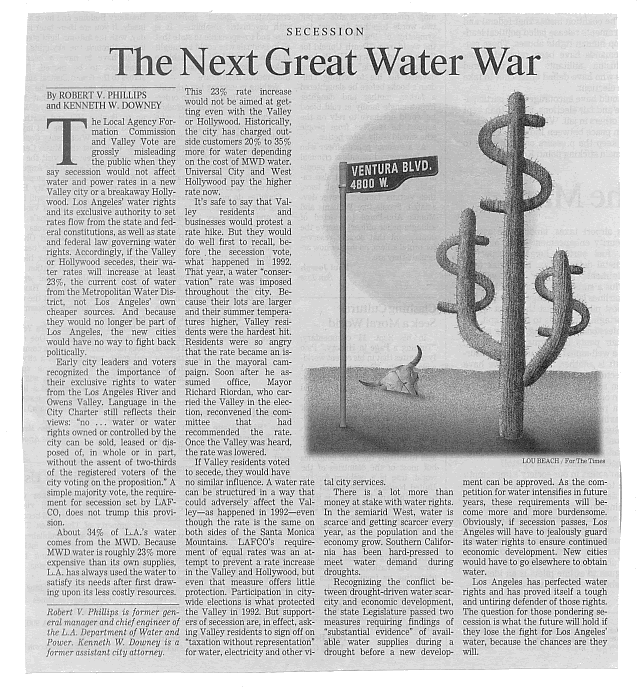
* * * * * |
Menu
- Home
- Mission
- Museum
- Major Efforts
- Recent Newsletters
- Historical Op Ed Pieces
- Board Officers and Directors
- Mulholland/McCarthy Service Awards
- Positions on Owens Valley and the City of Los Angeles Issues
- Legislative Positions on
Water Issues
- Legislative Positions on
Energy Issues
- Membership
- Contact Us
- Search Index
